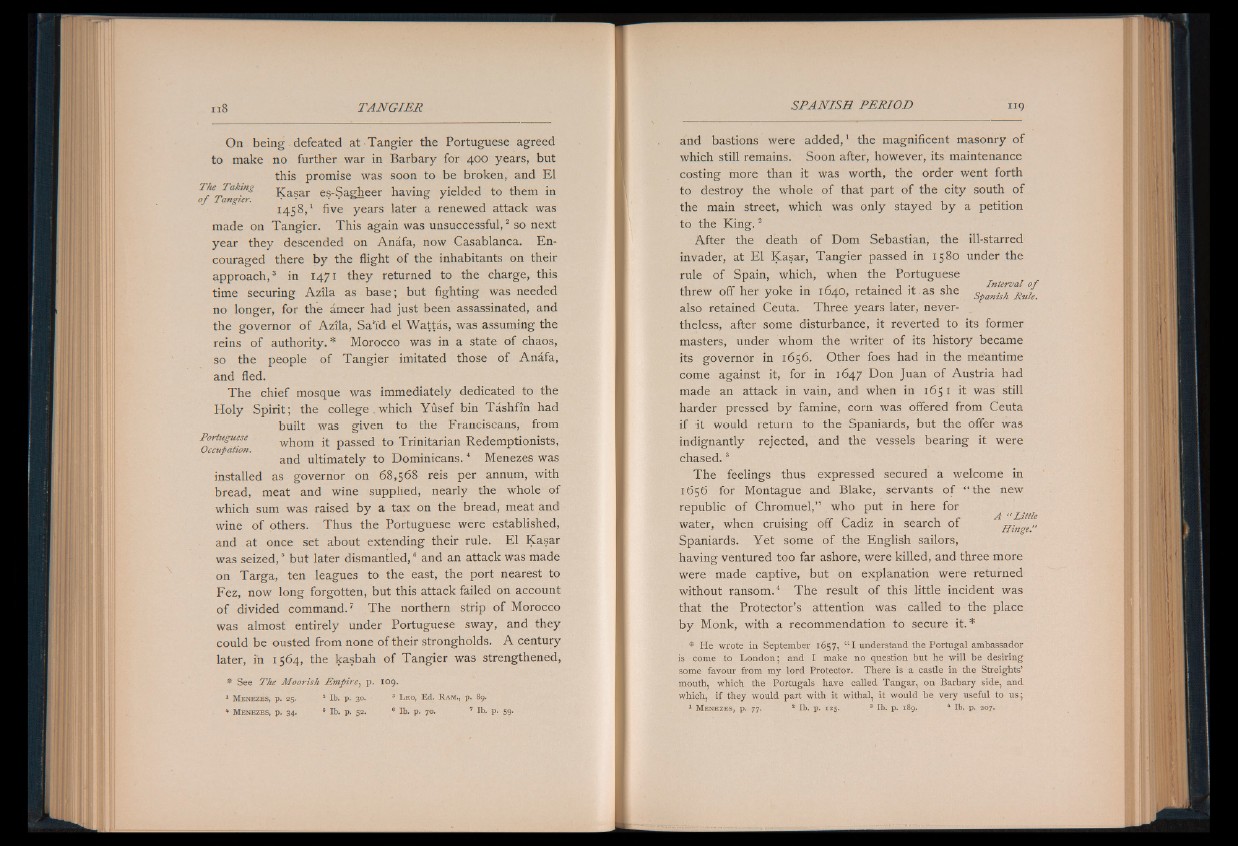
On being defeated at Tangier the Portuguese agreed
to make no further war in Barbary for 400 years, but
this promise was soon to be broken, and El
^ f6Tangier Kasar es-Sagheer having yielded to them in
145 8,1 five years later a renewed attack was
made on Tangier. This again was unsuccessful,2 so next
year they descended on Anafa, now Casablanca. Encouraged
there by the flight of the inhabitants on their
approach,3 in 1471 they returned to the charge, this
time securing Azila as base; but fighting was needed
no longer, for the ameer had just been assassinated, and
the governor o f Azila, Sa“id el Wattas, was assuming the
reins of authority.* Morocco was in a state of chaos,
so the people of Tangier imitated those of Anafa,
and fled.
The chief mosque was immediately dedicated to the
Holy Spirit; the co lle g e . which Yusef bin Tashfin had
built was given to the Franciscans, from
Portuguese whom it passed to Trinitarian Redemptionists,
Occupation. A .
and ultimately to Dominicans. Menezes was
installed as governor on 68,568 reis per annum, with
bread, meat and wine supplied, nearly the whole of
which sum was raised by a tax on the bread, meat and
wine of others. Thus the Portuguese were established,
and at once set about extending their rule. El Kasar
was seized,5 but later dismantled,6 and an attack was made
on Targa, ten leagues to the east, the port nearest to
Fez, now long forgotten, but this attack failed on account
of divided command.7 The northern strip of Morocco
was almost entirely under Portuguese sway, and they
could be ousted from none of their strongholds. A century
later, in 1564, the kasbah of Tangier was strengthened,
* See The Moorish Empire, p. 109.
1 Menezes, p. 25. 2 lb. p. 30. 3 L eo, Ed. R am., p. 89.
* Menezes, p. 34, 3 lb. p. 52. 6 lb. p. 70. 7 lb. p. 59.
and bastions were added,1 the magnificent masonry of
which still remains. Soon after, however, its maintenance
costing more than it was worth, the order went forth
to destroy the whole of that part of the city south of
the main street, which was only stayed by a petition
to the K in g .2
After the death of Dom Sebastian, the ill-starred
invader, at El Kasar, Tangier passed in 1580 under the
rule of Spain, which, when the Portuguese
• • 1 Interval o f
threw off her yoke in 1640, retained it as she Spanish Rule
also retained Ceuta. Three years later, nevertheless,
after some disturbance, it reverted to its former
masters, under whom the writer of its history became
its governor in 1656. Other foes had in the meantime
come against it, for in 1647 Don Juan of Austria had
made an attack in vain, and when in 165 1 it was still
harder pressed by famine, corn was offered from Ceuta
if it would return to the Spaniards, but the offer was
indignantly rejected, and the vessels bearing it were
chased.3
The feelings thus expressed secured a welcome in
1656 for Montague and Blake, servants of “ the new
republic of Chromuel,” who put in here for
. . A “ Little
water, when cruising off Cadiz in search of Hm*e"
Spaniards. Y e t some of the English sailors,
having ventured too far ashore, were killed, and three more
were made captive, but on explanation were returned
without ransom.4 The result of this little incident was
that the Protector’s attention was called to the place
by Monk, with a recommendation to secure it.*
- * He wrote in September 1657, “ I understand the Portugal ambassador
is come to London; and I make no question but he will be desiring
some favour from my lord Protector. There is a castle in the Streights’
mouth, which the Portugals have called Tangar, on Barbary side, and
which, if they would part with it withal, it would be very useful to us;
1 M e n e z e s , p . 77 . 2 lb . p . 12 5 . 3 lb . p . 189. 3 lb . p . 207.